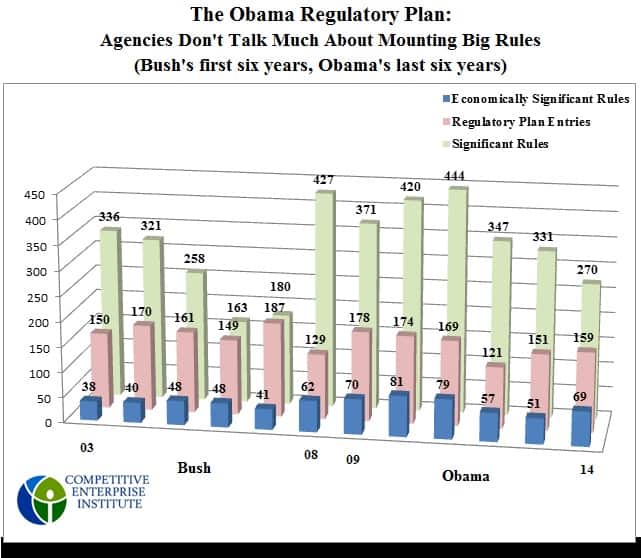Deteriorating White House Regulatory Disclosure Needs Active Congressional Review

Recently we’ve spent time reviewing Washington’s “Unified Agenda” of federal regulations, which came out just before Thanksgiving. It purports to tell what the alphabet soup of federal agencies has in store for you and yours.
The full name of the bi-annual publication is a mouthful: The Regulatory Plan and the Unified Agenda of Federal Regulatory and Deregulatory Actions.
The report appears twice a year, and has since 1983. Well, theoretically, that is; the Obama administration “opted out,” one might say, in Spring 2012, and otherwise maintains an odd schedule.
You can learn anything you want about federal taxation and spending. On the other hand, very little is concretely known about the regulatory state’s impacts apart from this report, and the White House’s annual reports to Congress on regulatory costs and benefits (which are also inadequate).
Unfortunately, what little reporting we get may be deteriorating further, driven by several factors. We have noted recent political considerations that restrained reporting, as well as internal reporting changes at the Office of Management and Budget that cause fewer long-term rules to be reported. (Yet even so, a higher number of “economically significant” and of small business-relevant rules are evident.)
In any event, the Fall 2014 Agenda contains a total of 3,415 rules and regulations in the pipeline.
Each year, as the full title of the document implies, a hundred or so of these get highlighted in executive agencies’ “Regulatory Plan” as priorities or notables. (Nearly all of these occupy at the “Active” stage; Just a handful of rules in the Plan over the past decade were in the “completed” and “long-term” phases.
One would have expected the Regulatory Plan to grow in scope and urgency during this administration:
- Economically significant rules (those with impacts one way or another of $100 million annually) have increased (averaging 46 annually under Bush but 68 under Obama);
- Rules impacting small business have increased under Obama;
- And rules deemed otherwise “significant” (under Executive Order 12866) in the Obama years vastly outstrip those of Bush (an element we’ll review later in another column).
But the Reg Plan hasn’t reacted, as the nearby chart’s middle row shows. The amount of agency upcoming actions deemed report-worthy in the Regulatory Plan has stayed virtually flat. When President Bush was in office from 2003-08, there were 946 Plan entries; for Obama, 952 Plan entries.

Note again that Obama’s economically significant rules are nearly 50 percent higher than Bush’s (first row) and his “significant” rules (third row, in back) are way above.
The Regulatory Plan is humming along, seemingly oblivious, as if nothing is going on worthy of attention. Under the Bush years, the Plan “kept up” more, so to speak (until 2008, it must be noted), with the level of significant regulatory activity that was actually happening.
This ought to concern policymakers; As one of the very few features of the federal regulatory apparatus that isolates and/or draws attention to significant regulatory movement, the Plan should better capture this heightened activity in some way, drawing attention to it and alerting Congress. In fact the regulatory state should always be pointing to itself, drawing interested and affected parties’ attention to it’s possible overreach, but it simply doesn’t care to do that.
Therefore, among many regulatory reforms needed in the new 114th Congress, here is yet one more way that regulatory disclosure needs a shot in the arm.